Guatemala
Playing Cards from Guatemala

Playing Cards from Guatemala
After arriving in what was named the ‘New World’, the Spanish sent expeditions to Guatemala, beginning in 1519. Before long, Spanish contact resulted in an epidemic that devastated native populations. During the colonial period, Guatemala was an Audiencia and a Captaincy General (Capitanía General de Guatemala) of Spain, and a part of New Spain (Mexico). The region was not as rich in minerals (gold and silver) as Mexico and Peru, but its main products were sugarcane, cocoa, blue añil dye, red dye from cochineal insects, and precious woods used in artwork for churches and palaces in Spain. In 1583 one Alonso Martínez de Orteguilla was authorised to administer the manufacture and sale of playing cards in New Mexico (which included Mexico, Nicaragua, Guatemala and Honduras). Playing cards were supplied from Spain and France, as well as manufactured in Mexico under licence.

Right: Spanish cards exported to new Spanish colonies, c.1550 onwards.
In recent years packs have been published in Guatemala by El Cuervo y Cia, Promotora Continental and ‘Juegos El Borrego’.
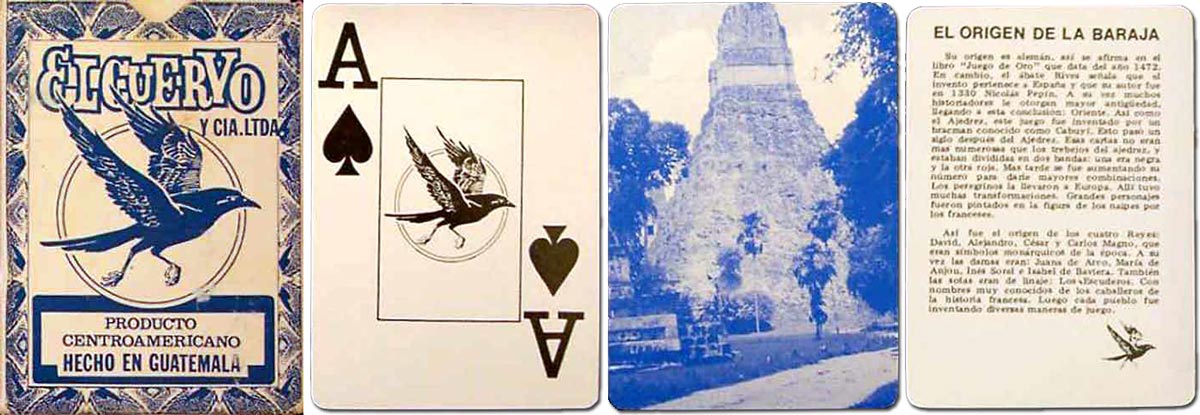
Above: box, Ace of Spades, back and extra card from French-suited pack manufactured by El Cuervo y Cia., Ltda, Guatemala, c.1970s. The extra card has a short text speculating about “the origin of the deck of playing cards”, which is stated as being either of German or Spanish origin, or possibly even as old as the game of chess, and also the origins of the four Kings, Queens, etc.
The Mayans lived in Guatemala, Honduras, Belize, the southern part of Mexico and northern parts of El Salvador until European settlers arrived.
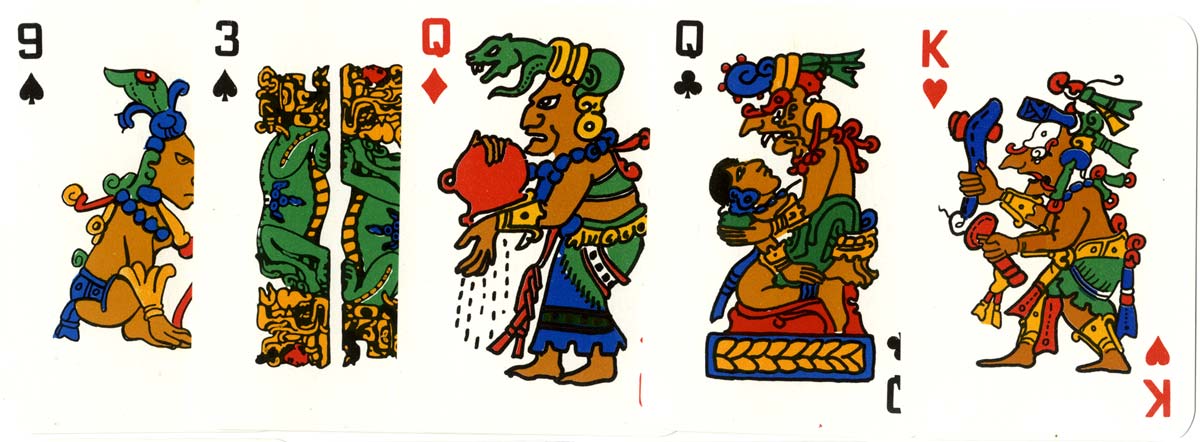
Above: Mayan Playing Cards - Baraja Maya - from Guatemala. 52 cards + 2 Jokers in box with explanatory leaflet in Spanish and English. See more →
By Simon Wintle
Spain • Member since February 01, 1996 • Contact
I am the founder of The World of Playing Cards (est. 1996), a website dedicated to the history, artistry and cultural significance of playing cards and tarot. Over the years I have researched various areas of the subject, acquired and traded collections and contributed as a committee member of the IPCS and graphics editor of The Playing-Card journal. Having lived in Chile, England, Wales, and now Spain, these experiences have shaped my work and passion for playing cards. Amongst my achievements is producing a limited-edition replica of a 17th-century English pack using woodblocks and stencils—a labour of love. Today, the World of Playing Cards is a global collaborative project, with my son Adam serving as the technical driving force behind its development. His innovative efforts have helped shape the site into the thriving hub it is today. You are warmly invited to become a contributor and share your enthusiasm.

Related Articles
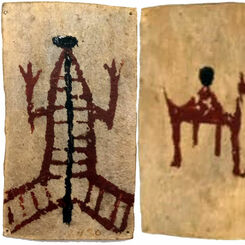
Aónikenk playing cards
Ethnographic playing cards made by members of the Aónikenk culture from Patagonia.

Cartas Precolombinas
Spanish playing cards with Pre-Columbian designs from Argentina, 2001.
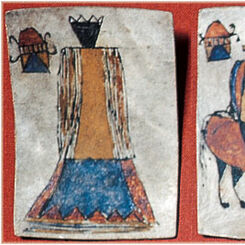
Apache cards by Tonto Naipero
Apache rawhide playing cards by ‘Tonto Naipero’, c.1871.
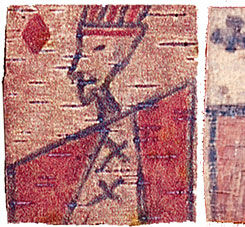
Ojibwa Native Indian Cards
Ojibwa Native Indian playing cards hand manufactured on birch bark in imitation of standard French /...
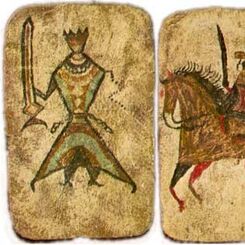
Apache Playing Cards
Apache Indian Playing Cards made on rawhide, first recorded 1875.

Mapuche Indian Playing Cards
Spanish-suited playing cards made on rawhide and said to have been used by Chilean Mapuche Indians, ...
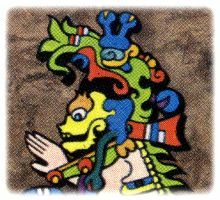
Maya Playing Cards
The designs of Mayan artists shown here give a general idea of their enormous artistic and cultural ...
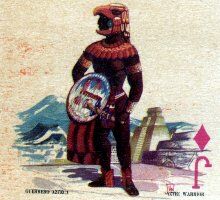
Aeronaves de Mexico
Special pack for Aeronaves de Mexico S.A., designed by Ramón Valdiosera Berman, mid-1960s.
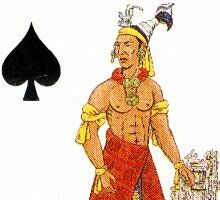
Mexican Poker
Mexican Poker cards made by Juegos y Fichas, S.A. de C.V., Mexico, 1991
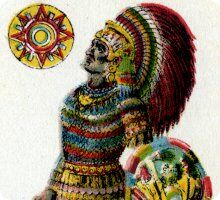
Naipes Nacionales
Naipes Nacionales designed by Manuel Bayardi and published by Clemente Jacques y Cia, Mexico c.1940....
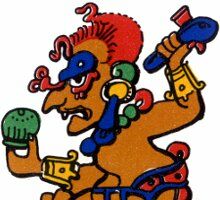
Mayan Cards
Mayan Playing Cards from Guatemala / Baraja Maya / containing illustrations of archaeology, art, fol...
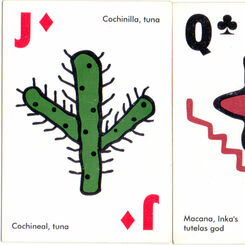
Inka Culture
Inka Culture playing cards, Peru, c.2000, promoting alpaca and cotton.
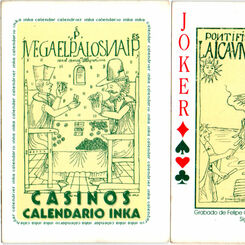
Calendario Inka
“Calendario Inka” playing cards published by Power Casinos, Lima, Peru, c.2004.
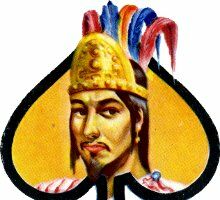
Baraja Cuauhtémoc
Baraja Cuauhtémoc published by Treviño Narro, Monterrey, Mexico Original artwork by P. X. Santaella ...

Native Indian Hand-made Cards made on rawhide
Native Indian hand-made cards made on rawhide.

El Ferrocarril
Naipe El Ferrocarril made by La Cubana, S.A. (Fabrica de Naipes El Aguila), Mexico, c.1960
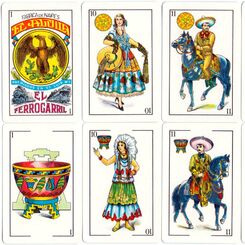
Playing Cards from Mexico
MEXICO shares a long tradition with Spain in the field of playing cards and also merges two complete...

Cusco Inca Souvenir
Pre-Incas & Incas Souvenir Playing Cards, Cusco, Peru, 2000.
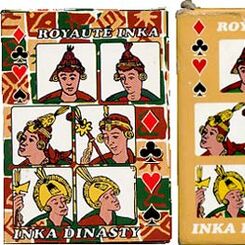
Inka-Dynasty
'Inka-Dynasty' playing cards are based on historic 16th century designs by the Peruvian chronicler F...
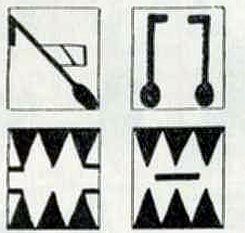
Las Cartas de Tacuabe by Manos del Uruguay
Tacuabé was a Charrúa native from Uruguay, an indigenous tribe that became extinct following Europea...
Most Popular
Our top articles from the past 60 days






















